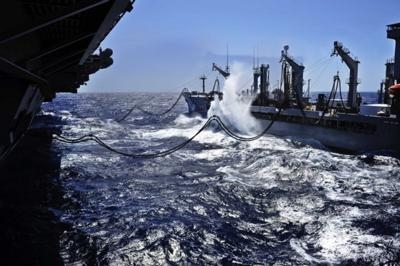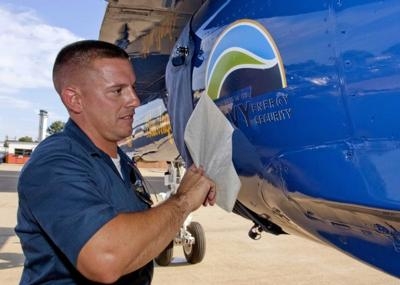Mon, Jul 23, 2012
Aircraft Flying On A Camelina Oil-Jet Fuel Blend
NAVAIR’s fuels team is helping the Navy move closer to its goal of deploying a “fleet of ships powered by biofuels.” The fuels team developed a 50/50 blend of camelina oil and JP-5 jet fuel for aircraft and a 50/50 blend of F-76 petroleum and algae-based biofuel to power the ship engines being used during the biennial Rim of the Pacific, or RIMPAC, exercise.

The fuel delivery is part of the Navy's Great Green Fleet demonstration, which allows the Navy to test, evaluate and demonstrate the cross-platform utility and functionality of advanced biofuels in an operational setting.
The Green Strike Group demonstration will use 900,000 gallons of the blend during the exercise. The demonstration is a critical component of the Navy's Test and Qualification process, said NAVAIR fuels team lead Rick Kamin. The exercise is used for approving fuels produced from renewable sources for inclusion in the Navy's JP-5 (shipboard aviation fuel) and F-76 (marine diesel fuel) specifications, Kamin said. “This demonstration provides an opportunity to have the fleet personnel assess the performance of tactical Naval Fuels [JP-5 and F-76] produced from renewable sources in an operational environment,” Kamin said. “Fuel performance will be evaluated for the entire path of the fuel, from shore base storage to the end consumer -- ship or aircraft.”
Begun as an annual exercise in 1971, RIMPAC is a multinational maritime exercise that takes place in and around the Hawaiian Islands. RIMPAC 2012 began June 29 and is scheduled to run through Aug. 3. It features 22 nations, 40 surface ships, six submarines, more than 200 aircraft and 25,000 personnel.

Biofuel was first used by non-test and evaluation pilots last September when the Blue Angels flight demonstration team used it during the NAS Patuxent River Air Expo. The six F/A-18 jets performed their flight demonstration without any problems, an official with the team said.
“To put it into perspective, I fly this airplane about 400 times a year, so I am very in tune with the airplane itself,” Navy Capt. Greg McWherter, Blue Angels commanding officer, said in an interview last September. “For me to get in there and see almost no difference between the biofuel and our normal JP variant is amazing. The fuel performed flawlessly and we are very excited about demonstrating that capability. I wouldn’t fly with my wingmen if I didn’t have 100 percent confidence that it was good.”
For flight demonstration, the Navy requires the 50/50 camelina/JP-5 biofuel be a drop-in replacement for petroleum-based fuel; have no notable operational differences; and be able to be mixed or alternated with petroleum fuel. It also must require no changes to the Navy’s existing fuel storage or transfer infrastructure.
The demonstration of the “Green Strike Group” is a precursor to the secretary of the Navy’s 2016 goal of deploying a fully operational “Great Green Fleet.”
(Photos provided by the U.S. Navy)
More News
Terminal Radar Service Area Airspace surrounding designated airports wherein ATC provides radar vectoring, sequencing, and separation on a full-time basis for all IFR and participa>[...]
Aero Linx: Utah Back Country Pilots Association (UBCP) Through the sharing experiences, the UBCP has built upon a foundation of safe operating practices in some of the most challen>[...]
From 2010 (YouTube Edition): Imagine... Be The Change... Inspire FROM 2010: One of the more unusual phone calls I have ever received occurred a few years ago... from Anousheh Ansar>[...]
(Pilot) Felt A Shudder And Heard The Engine Sounding Differently, Followed By The Engine Chip Detector Light On April 14, 2025, about 1800 Pacific daylight time, a Bell 206B, N1667>[...]
Also: AMA Names Tyler Dobbs, More Falcon 9 Ops, Firefly Launch Unsuccessful, Autonomous F-16s The Air Force has begun ground testing a future uncrewed jet design in a milestone tow>[...]
 ANN's Daily Aero-Term (05.07.25): Terminal Radar Service Area
ANN's Daily Aero-Term (05.07.25): Terminal Radar Service Area ANN's Daily Aero-Linx (05.07.25)
ANN's Daily Aero-Linx (05.07.25) Classic Aero-TV: Anousheh Ansari -- The Woman Behind The Prize
Classic Aero-TV: Anousheh Ansari -- The Woman Behind The Prize NTSB Prelim: Bell 206B
NTSB Prelim: Bell 206B Airborne-NextGen 05.06.25: AF Uncrewed Fighters, Drones v Planes, Joby Crew Test
Airborne-NextGen 05.06.25: AF Uncrewed Fighters, Drones v Planes, Joby Crew Test




